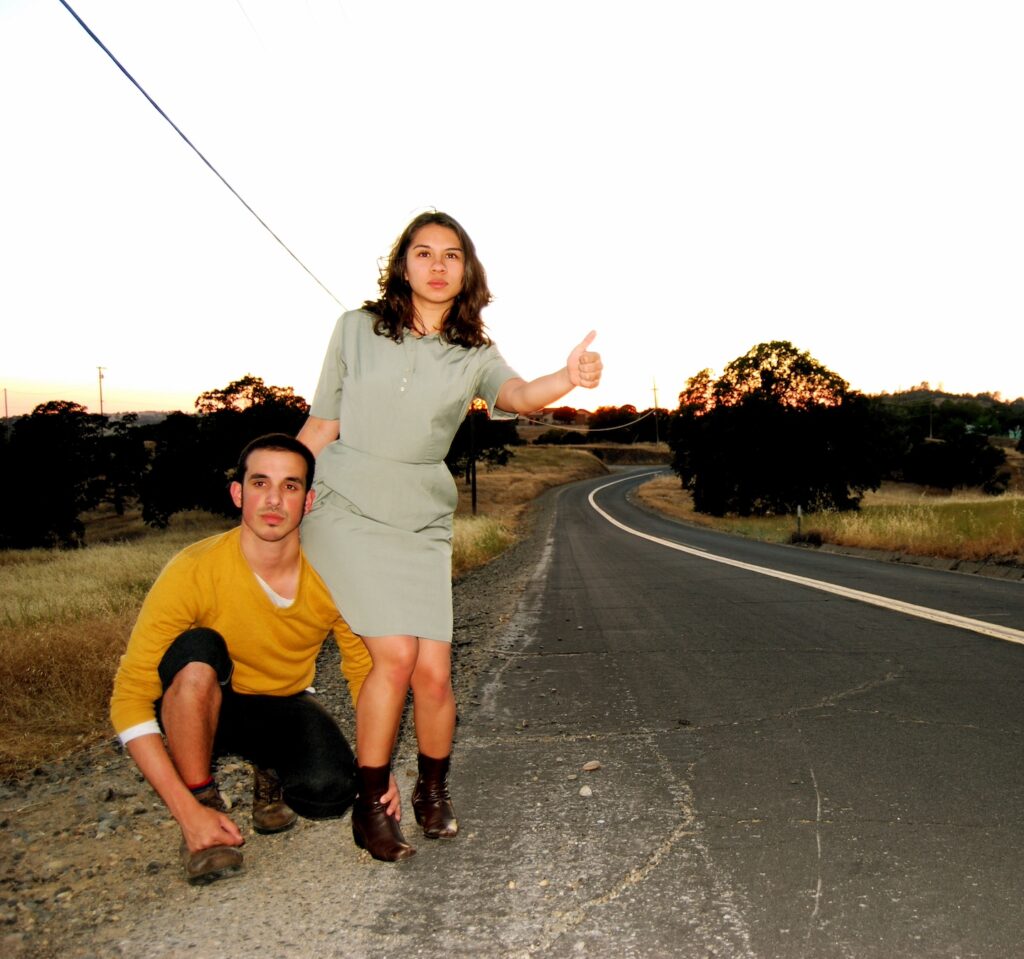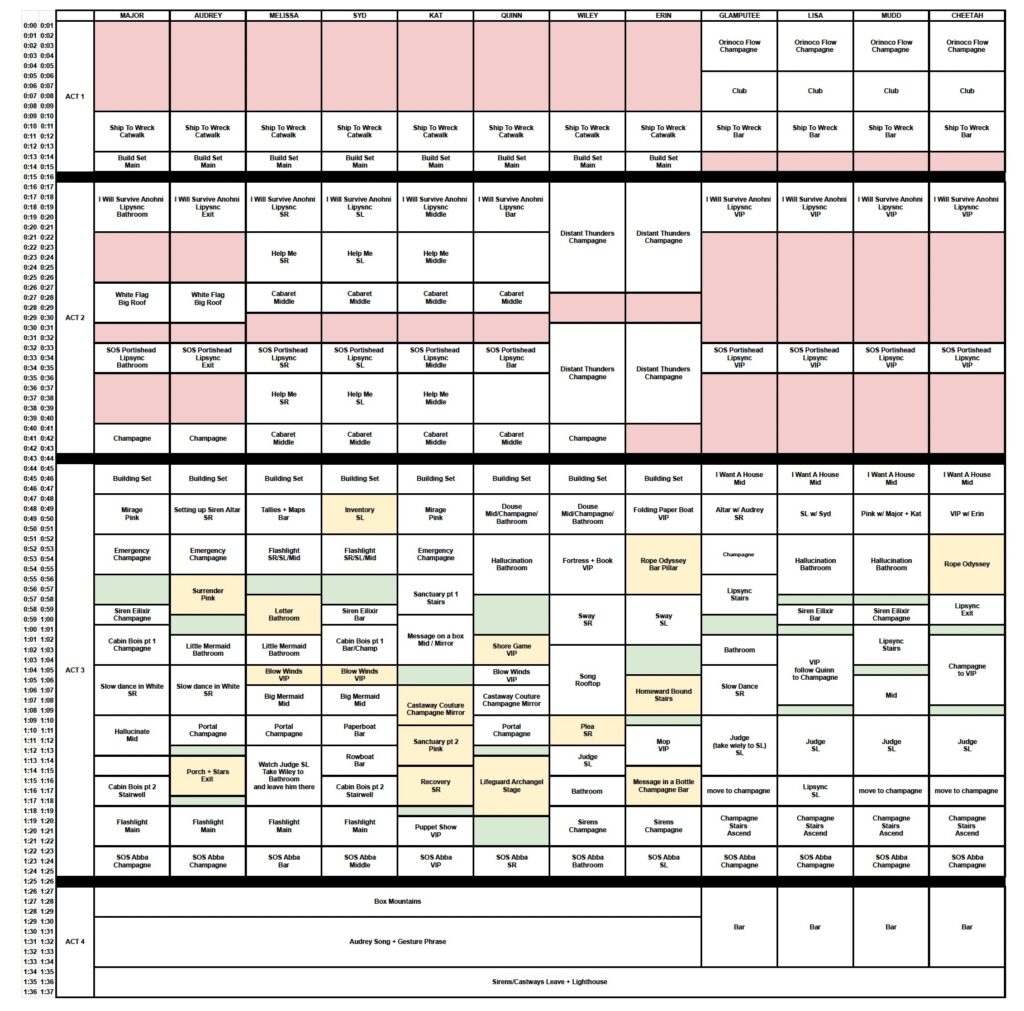For fifteen years we’ve directed Detour, a performance company that embodies queer maximalism and an ensemble approach to devising work.
We weren’t always like that.
Fifteen years ago we were a contemporary dance company (or “troupe” as one news article called us). We were dance babies self-producing work out of The Garage, CounterPulse, Studio 210.
Babies.

[ID: Eric and Kat hitchhiking on the side of a country road at sunset. Eric has short black hair, rosy cheeks, and is squatting on one knee next to Kat, who has shoulder-length brunette hair. Behind them are silhouetted trees and rolling hills with a big open sky and a slight orange glow.]
Since then, we’ve shifted into crafting work for unconventional spaces, most recently OASIS (a cornerstone queer night club along with the revival of the STUD!) and The General’s Residence in the Presidio (think: haunted ballrooms, decadent decor, a view of the piers).
We’ve gone from being Detour Dance to Detour Productions. It was a way to honor that dance, while still a part of our practice, isn’t the only toy in the sandbox anymore.
More is more.
Why does Detour drag?
- Affirmation (tip$$$, vocal cheers, eye contact)
- Connection
- Risk is Celebrated
- High Reward
- Entertainment
- Brief but Mighty
- Dynamic, Bold Expression (deeply personal to camp to emotional ballad to choreographed spectacle)
- Referential
- The Form Itself: costume design, lipsync, makeup, skill-sharing
- Familial
Why does Detour dance/theater?
- Rehearsing/crafting for long periods of time
- Ensemble Creation
- Building and stacking scenes/sequences
- Building the plane as we fly it not quite knowing where we’ll be in the end but trusting in the p r o c e s s
It’s the liberatory, immediate energy of queer nightlife
paired with
the nuanced, multidimensional world-building of dance and theater
& it all comes together in a seemingly chaotic but rigorously conceived format of (inhale)
**immersive theater**
Doesn’t that sound yummy?
Within the container of immersive theater, we’re asking:
- What is the dynamic between the devisers/performers and the audience? How do we continue to keep the audience’s experiences in mind as we build?
- What work is needed to be responsive to the audience, and allow their engagement, spontaneity and autonomy inform the work?
How are we building this plane?
This is a (non-exhaustive) list of some of our approaches:
- As an ensemble, each person creates scenes based on a concept or theme. We see each other as artists and creators in our own right, and there’s a lot of liberty and responsibility for each person to refine their own character and scenes.
- We share our developing scenes with one another and invite feedback and ideas—everyone is welcome to share their opinions.
- The keeper of the vision is Eric. He’ll take stock of what’s being built and organize the show’s main arc, oftentimes “swapping” creative material between people. In that sense, the work we’re creating is non-proprietary and can be gifted to anyone in the group to use.
- Scenes are stacked together through a very intense process of trial-and-error. For our 2023 show, We Build Houses Here, we tried dozens of different orders for our scenes until we found the right balance of energy and timing.
- We must shed our performer ego/individualism, knowing there’s a chance that no one is seeing our scene, trusting that the larger vision of the work is being held by all. The narrative, so to speak, isn’t held by one person or one experience but instead by the collective, who all hold a piece of the totality.
- We also trust our abilities to take care of ourselves and one another. An access check-in at the start of every rehearsal allows people to share where they are at and how we can support them. This trust extends to the performances, where we are tuning into and listening to one another.
- In practical terms, this means that performers are not only aware of their roles within a scene but also continuously revising and adapting in response to the audience. This dynamic interplay requires both a keen sense of improvisation and a solid grasp of the narrative and spatial context, and pulls from the spontaneity and presence that drag invites us into.
- It’s about navigating a three-dimensional performance space, engaging with audience members on a personal level, and guiding them through a complex web of interactions and sensory experiences.

[ID: Graphic of an excel spreadsheet/visual document of the scene order/show structure for Detour’s We Build Houses Here. There are 12 columns for each performer and dozens of rows that signal minute-by-minute timestamps, broken up into the four acts. Black text on a white background.]
And what happens with the audience?
A list of hopes, and invitations:
- Step out of the traditional confines of passive observation into a realm where you and your choices significantly impact the experience;
- Navigate the space, make choices, place yourselves in environments that react to your presence;
- And by doing so, alchemize interaction and spontaneity from everyone present.
A prism of sorts.
Immersive theater allows us to explore the boundaries of creativity and human interaction, for performers and audiences alike, and offer experiences as diverse and dynamic as the people who participate in them.
As we do, we turned to our ensemble of collaborators to share thoughts on what this process is for them. We want to emphasize here that, while Detour provides the container and structure for the work to happen, the real culture and impact that the ensemble feels is something that each of them has co-created. It comes from the openness, care and trust that each of them bring to the process. It is a daily choice to show up like this, in the same ways we want to be held and listened to:
“I felt trusted, valued, and challenged. Working quickly, not questioning first impulses, and assigning a seemingly-random site for a performance module puts me in a sexy place to be creative… Then using prompts and randomization, let each performer build and inhabit their own dossier of character, born out of their performance strengths. It was all very mathematically orchestrated in its construction. And it worked. It challenged me to let go of my usual rehearse/refine/perfect performance style and live in a react/respond/breathe mindset.” Kevin Clarke
“For me, the most important part of theater and performance is the communal experience…In a Detour show, it feels like… I happen to be in the role of glittery performer, and you happen to be in the role of audience member, but we can also feel that we are human animals in a small space together. Ensemble created work is so hard and gratifying. Sometimes you’re just dancing with a mop around in a room by yourself wondering what the fuck you’re doing. Sometimes you’re all fumbling around together trying to figure something out. What is this thing? You live together in the unknown. And you miraculously do SOMETHING even when you don’t know what you’re doing. You keep reminding yourself to trust. You find ways to pour some essential part of yourself into this crazy vessel and share it.” Erin Mei-Ling Stuart
“The ensemble nature of these devised pieces means I have a wealth of artistic knowledge to draw upon from a diversity of talent who are mutually invested in each other’s success, growth, and caliber of the collective performance. What’s more is Detour’s radical commitment to collective access principles, inviting in access checks at each rehearsal and providing accessibility support for performers and audience alike. This praxis subverts the antiquated notion that only disabled people’s body/minds have needs, which is refreshing and healing to feel the pressure taken off me as a disabled person to proactively self-advocate to ensure my (and people in my communities) experiences will be considered in the production.” Alex Locust
“My experience with Detour is one of care and having the performers’ backs… which is something I have never experienced before. Putting the performers well-being to the front of the conversation really helped me take care of myself and gave me the ability to put my best performance forward.” Lisa Frankenstein
“My experiences with Detour’s ensemble-devised/immersive theatrical productions have been nothing short of healing. The combination of the process of collective consciousness, personal expression, and integral skill sets is what has set my experience with this production team apart from anything I’ve ever done before.” Mudd the Two Spirit
“Working with Detour makes me think of… permissions, being summoned to create with my whole self. A place where I am treated with love and respect in my messiest states. Alchemize the fraught and chaotic experience of discovery into something I can learn from and look upon with compassion.” Quinn Dixon
This article appeared in the Fall 2024 issue of In Dance.
Eric Garcia is a San Francisco-based devised dance-theater artist, drag queen, community organizer, and the Co-Director of Detour. He creates immersive and site-responsive performances that straddle nostalgia, radical futurism, collaborative ensembles, and queer maximalism. He has worked with men in detention, senior adults, trans and queer youth, drag performers, and self-identified non-dancers on various dance films and live performance projects. Eric is rooted in the queer nightlife and drag performance scene as Churro Nomi, and produces/hosts Clutch The Pearls, a drag cabaret on the first Sunday of every month at Make-Out Room in the Mission District. Since 2010, Eric proudly serves as Managing Director for both Fresh Meat Productions and the SF Transgender Film Festival.
Kat Gorospe Cole is a Bay-Area based director and producer working in film and live performance. She formerly served as Development Manager and later Program Manager for CounterPulse, and has worked in production and arts management for several other Bay Area arts organizations. They have worked as an Associate Producer for Academy and Emmy-winning directors Rob Epstein and Jeffrey Friedman, and was the Associate Producer for Boots Riley’s I‘M A VIRGO. Her short films have screened in over 25 festivals including Hot Docs, NewFest, CAAMfest, Los Angeles Asian Pacific American Film Festival, New Orleans Film Festival and Outfest. She was awarded Best Bay Area Director from the Coven Film Festival. He moonlights as the drag king Sir Acha.


